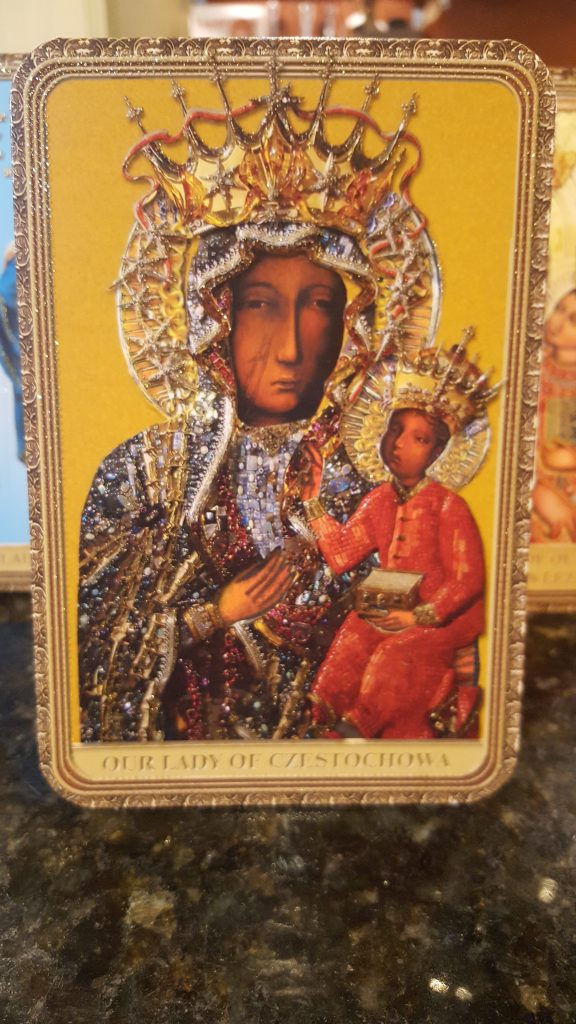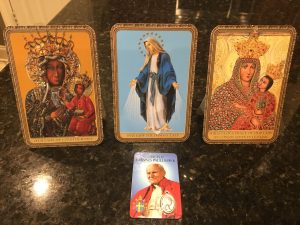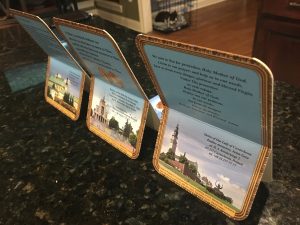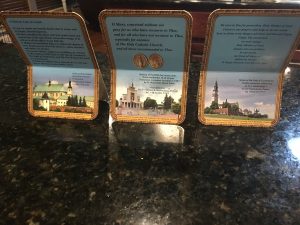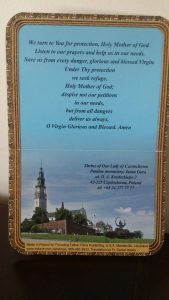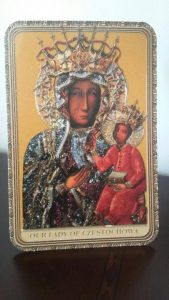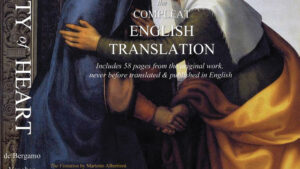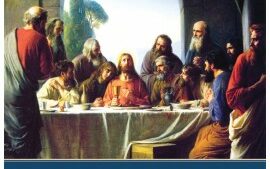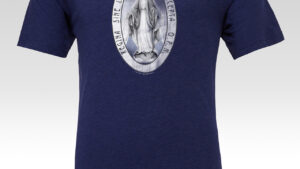Description
Our Lady of Częstochowa Prayer Card
4×6 prayer card w/ pop out bottom for display
You can get all 3 prayer cards for $12.99 by selecting the option!
Each prayer card is $5.99
Prayer:
We turn to You for protection, Holy Mother of God. Listen to our prayers and help us in our needs. Save us from every danger, glorious and blessed Virgin. Under Thy protection we seek refuge, Holy Mother of God; despise not our petitions in our needs, but from all dangers deliver us always, O Virgin Glorious and Blessed. Amen
History of the image:
The origin of this miraculous image in Czestochowa, Poland is unknown for absolute certainty, but according to tradition the painting was a portrait of Our Lady done by St. John sometime after the Crucifixion of Our Lord and remained in the Holy Land until discovered by St. Helena of the Cross in the fourth century. The painting was taken to Constaninople, where St. Helena’s son, the Emperor Constantine, erected a church for its enthronement. This image was revered by the people of the city.
During the siege by the Saracens, the invaders became frightened when the people carried the picture in a procession around the city; the infidels fled. Later, the image was threatened with burning by an evil emperor, who had a wife, Irene, who saved it and hid it from harm. The image was in that city for 500 years, until it became part of some dowries, eventually being taken to Russia to a region that later became Poland.
After the portrait became the possession of the Polish prince, St. Ladislaus in the 15th century, it was installed in his castle. Tartar invaders besieged the castle and an enemy arrow pierced Our Lady’s image, inflicting a scar. Interestingly, repeated attempts to fix the image, artistically have all failed.
Tradition says that St. Ladislaus determined to save the image from repeated invasions, so he went to his birthplace, Opala, stopping for rest in Czestochowa; the image was brought nearby to Jasna Gora [“bright hill”] and placed in a small wooden church named for the Assumption. The following morning, after the picture was carefully placed in the wagon, the horses refused to move. St. Ladislaus understood this to be a sign from Heaven that the image should stay in Czestochowa; thus he replaced the painting in the Church of the Assumption, August 26, 1382, a day still observed as the Feast Day of the painting. The Saint wished to have the holiest of men guard the painting, so he assigned the church and the monastery to the Pauline Fathers, who have devoutly protected the image for the last six hundred years.
Having survived two attacks upon it, Our Lady’s image was next imperiled by the Hussites, followers of the heretic priest, John Hus from Prague. The Hussites did not accept papal authority as coming from Christ and taught that mortal sin deprived an office holder of his position, among other heresies. Hus had been influenced by John Wyclif and became infected with his errors. Hus was tried and condemned at Constance in 1415. The Hussites successfully stormed the Pauline monastery in 1430, plundering the sanctuary. Among the items stolen was the image. After putting it in their wagon, the Hussites went a little ways but then the horses refused to go any further. Recalling the former incident that was so similar, the heretics threw the portrait down to the ground, which shattered the image into three pieces. One of the plunderers drew his sword and slashed the image twice, causing two deep gashes; while attempting a third gash, he was overcome with a writhing agony and died.
The two slashes on the cheek of the Blessed Virgin, together with the one on the throat, not readily visible in our copy, have always reappeared after artistic attempts to fix them. The portrait again faced danger in 1655 by a Swedish horde of 12,000, which confronted the 300 men guarding the image. The band of 300 routed the 12,000 and the following year, the Holy Virgin was acclaimed Queen of Poland.
In September 14, 1920, when the Russian army assembled at the River Vistula, in preparation for invading Warsaw, the Polish people prayed to Our Lady. the next day was the Feast of Our Lady of Sorrows. The Russians quickly withdrew after the image appeared in the clouds over Warsaw. In Polish history, this is known as the Miracle of Vistula.
During the Nazi occupation of Poland in World War II, Hitler order all religious pilgrimages stopped. In a demonstration of love for Our Lady and their confidence in her protection, a half million Poles went to the sanctuary in defiance of Hitler’s orders. Following the liberation of Poland in 1945, a million and a half people expressed their gratitude to the Madonna by praying before this miraculous image.
Twenty-eight years after the Russian’s first attempt at capturing the city, they successfully took control of Warsaw and the entire nation in 1948. That year more than 800,000 brave Poles made a pilgrimage to the sanctuary at Czestochowa on the Feast of the Assumption, one of the three Feast days of the image; the pilgrims had to pass by the Communist soldiers who patrolled the streets.
Today, the Polish people continue to honor their beloved portrait of the Madonna and Child, especially on August 26, the day reserved by St. Ladislaus. Because of the dark pigment on Our Lady’s face and hands, the image is affectionately called the “Black Madonna,” most beautifully prefigured in the Bible, in the Canticle of Canticles, “I am black but beautiful.” The pigmentation is ascribed primarily to age and the need to keep it hidden for long periods of time in places where the only light was from candles, which colored the painting with smoke.
The miracles attributed to Our Lady of Czestochowa are many and most spectacular. The original accounts of them, some of them cures, are archived by the Pauline Fathers at Jasna Gora.
Papal recognition of the miraculous image was made by Pope Clement XI in 1717. The crown given to the image was used in the first official coronation of the painting, which was stolen in 1909.
Pope Pius X replaced it with a gold one encrusted with jewels.

 Cart is empty
Cart is empty 